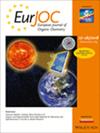Fluorescent β‐Sheet‐Based Peptide Hydrogels with Aggregation‐Enhanced Emission Properties
IF 2.7
3区 化学
Q2 CHEMISTRY, ORGANIC
引用次数: 0
Abstract
Novel fluorescent peptide hydrogels are reported by combining 1,8‐naphthalimide‐derived amino acids with a previously developed peptide‐based controlled drug release matrix. Aggregation‐enhanced emission is achieved by inserting the fluorescent naphthalimide moieties in a peptide sequence with self‐assembling properties. The formation of β‐sheets directs the orientation of the luminescent side chains, leading to the avoidance of aggregation‐caused quenching. The relation between the β‐sheet‐underpinned fiber formation and the emission characteristics is further elucidated by spectroscopic and microscopic techniques, including correlative fluorescence and atomic force microscopy imaging. Owing to the incorporation of the naphthalimide moiety, the gelation concentration is lowered and the gel strength improved. The resulting hydrogels does not contain any organic solvent (in contrast to ample literature examples), present thixotropic behavior, and the fluorescent properties are sensitive to environmental conditions such as temperature and medium. These features make the soft biomaterials interesting for applications such as biosensing, real‐time bioimaging, and 3D printing. The high tunability of the peptide sequence composition and configuration, as well as the chemical structure of the 1,8‐naphthalimide moiety, allows for modulating the material toward desired properties.

具有聚集增强发射特性的基于β -薄片的荧光肽水凝胶
新型荧光肽水凝胶是将1,8 -萘酰亚胺衍生的氨基酸与先前开发的基于肽的药物释放基质结合而成的。聚集增强发射是通过在具有自组装特性的肽序列中插入荧光萘酰亚胺部分来实现的。β -薄片的形成指导了发光侧链的取向,从而避免了聚集引起的猝灭。通过光谱和显微技术,包括相关荧光和原子力显微镜成像,进一步阐明了β片支撑纤维形成与发射特性之间的关系。由于萘酰亚胺部分的掺入,降低了凝胶浓度,提高了凝胶强度。所得水凝胶不含任何有机溶剂(与大量文献示例相反),呈现触变行为,并且荧光特性对环境条件(如温度和介质)敏感。这些特性使软生物材料在生物传感、实时生物成像和3D打印等应用中变得有趣。肽序列组成和构型的高度可调性,以及1,8‐萘酰亚胺部分的化学结构,允许调节材料的所需性能。
本文章由计算机程序翻译,如有差异,请以英文原文为准。
求助全文
约1分钟内获得全文
求助全文
来源期刊
CiteScore
5.40
自引率
3.60%
发文量
752
审稿时长
1 months
期刊介绍:
The European Journal of Organic Chemistry (2019 ISI Impact Factor 2.889) publishes Full Papers, Communications, and Minireviews from the entire spectrum of synthetic organic, bioorganic and physical-organic chemistry. It is published on behalf of Chemistry Europe, an association of 16 European chemical societies.
The following journals have been merged to form two leading journals, the European Journal of Organic Chemistry and the European Journal of Inorganic Chemistry:
Liebigs Annalen
Bulletin des Sociétés Chimiques Belges
Bulletin de la Société Chimique de France
Gazzetta Chimica Italiana
Recueil des Travaux Chimiques des Pays-Bas
Anales de Química
Chimika Chronika
Revista Portuguesa de Química
ACH—Models in Chemistry
Polish Journal of Chemistry.

 求助内容:
求助内容: 应助结果提醒方式:
应助结果提醒方式:


